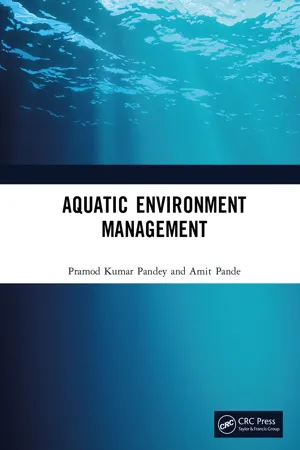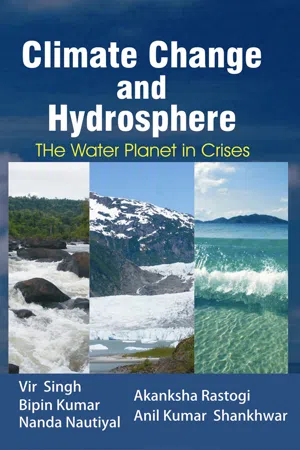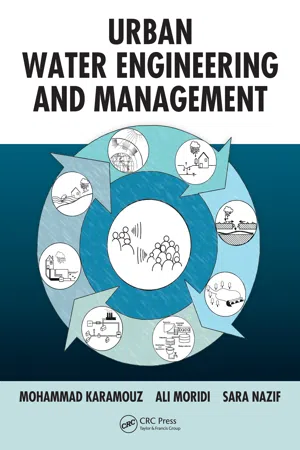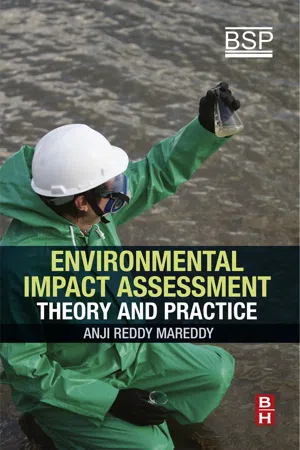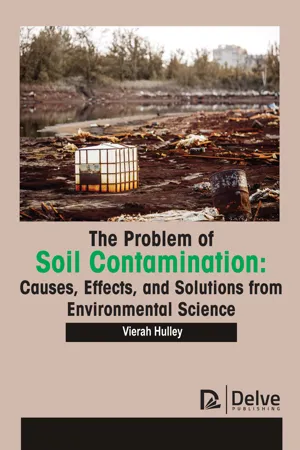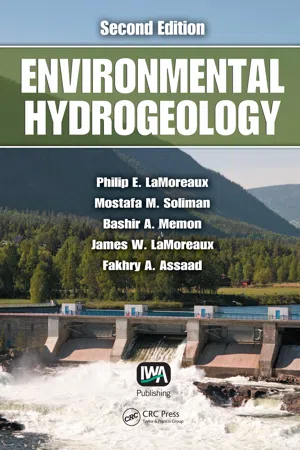Geography
Impact of Polluted Water
The impact of polluted water includes adverse effects on human health, ecosystems, and the economy. Contaminated water can lead to waterborne diseases, harm aquatic life, and disrupt food chains. Additionally, it can result in economic losses due to decreased agricultural productivity and increased healthcare costs.
Written by Perlego with AI-assistance
Related key terms
1 of 5
8 Key excerpts on "Impact of Polluted Water"
- eBook - ePub
- Pramod Kumar Pandey, Amit Pande(Authors)
- 2023(Publication Date)
- CRC Press(Publisher)
7 Aquatic Pollution and Its ImpactDOI: 10.1201/9781003313137-7About 71% of the globe’s surface is covered by water, while the seas contain 97% or 320 million cubic miles. Less than 3% of the water on the Earth is fresh, of which 2.5% is unavailable because it is trapped in glaciers, polar ice caps, the atmosphere, and soil. It is highly contaminated or is too deep to be retrieved at a reasonable cost. Only 0.5% of freshwater is accessible to the world’s water supply. Nature continuously gathers, cleans, and distributes water through the water cycle.Water, the lifeline of life, supports all life forms and constitutes 70% or more of an organism’s weight. The Earth distinguishes itself from all other planets as it has water that supports life. Without water, human beings, animals, and plants would perish. Aquatic environments are known as homes for the diverse assemblage of organisms. About 4,300,000 km3 of freshwater is to be shared among the Earth’s inhabitants. Water is more versatile than any other liquid on the Earth and is known as a universal solvent because of its capability to dissolve several chemical compounds or suspend particulate organic matter. Whether water is clean enough for use or too polluted to harm hangs on how the users deal with it.The accidental or purposeful introduction of hazardous elements or pollutants into the environment is known as pollution. Pollutants are dangerous substances that harm the environment’s quality, making it unsuitable for the survival of living organisms. Pollutants could be natural or a result of anthropogenic activity. Natural pollutants include volcanic ash, soil run-offs from erosion, and landslides. Anthropogenic activities contribute towards a significant chunk of pollution, for instance, industrial run-off or waste that may enter the environment through air or water. The word pollution originates from the Latin termpolluere,which means to contaminate. Therefore, a pollutant can be defined as anything that contaminates the environment. Pollution is the presence of substances or pollutants in the air, land, and water that can harm living things and the environment. The phrases pollution, contamination, and degradation (of water) have all been used interchangeably to denote poor water quality. When a contaminant is added to water, the native properties of water are altered, which prevents the riparian owner from obtaining the stream’s purest natural water. Such water is deemed to be contaminated. The definition of pollution that was most widely accepted in the 1970s wasunacceptable interference of a material’s chemical composition or quantity in the environment, which results in undesirable environmental and health repercussions and impairs the functioning of natural processes. - Singh, Vir(Authors)
- 2021(Publication Date)
- Biotech(Publisher)
Polluted water is turbid, unpleasant, having bad smell and is unfit for drinking as well as bathing and washing purposes. Polluted water is harmful and is a vehicle for many diseases, such as cholera, dysentery, typhoid etc. Other diseases are like abdominal pain, skin lesions, dizziness, constipation, indigestion, burning sensations in chest and stomach, skin discoloration, suppression of lactation, underweight births, birth defects, child growth retardation and contaminated breast milk. Urbanization and the unregulated growth of the population have altered the surface and subsurface terrains of the many areas. Changes in local topography and drainage system directly affect both quality and quantity of the groundwater (Vasanthavigar et al ., 2010). Temporal changes in the origin and constitution of the recharged water, hydrological human factors may cause periodic changes in the groundwater quality. Water pollution not only affects water quality but also threats human health, economic development and social prosperity (Milovanovic, 2007). River basins are highly vulnerable to pollution due to absorption and transportation of domestic, industrial and agricultural waste water; therefore it is significant to control water pollution and monitor water quality (Simeonov et al ., 2003). Over burden of the population pressure, unplanned urbanization, unrestricted exploration policies and dumping of the polluted water at This ebook is exclusively for this university only. Cannot be resold/distributed. inappropriate place enhance the infiltration of harmful compounds to the groundwater. Studies regarding the groundwater quality analysis have been made by many authors (Gupta and Gupta, 1999; Rajasekara et al ., 2005; Rajan and Paneerselvam, 2005; Thakare et al ., 2005; Bisht et al ., 2007).- eBook - PDF
- Rose Marie O. Mendoza(Author)
- 2019(Publication Date)
- Arcler Press(Publisher)
INTRODUCTION TO WATER POLLUTION AND WATER QUALITY 1 CHAPTER CONTENTS 1.1 Introduction ......................................................................................... 2 1.2 Uses of Water ...................................................................................... 5 1.3 Requirements of Water Quality ............................................................ 7 1.4 Characterization of Water Bodies ....................................................... 10 1.5 Definitions Related to Quality of Water ............................................. 17 1.6 Anthropogenic Effects on Water Quality ............................................ 19 1.7 Temporal And Spatial Variations ......................................................... 24 1.8 Economic Development and Quality of Water ................................... 27 1.9 Water Pollution .................................................................................. 29 References ............................................................................................... 32 Biochemical Ecology of Water Pollution 2 1.1 INTRODUCTION Majority of people in Europe have an easy access to good quality drinking water. Still, in some areas, the quality of water often does not meet basic chemical and biological standards. Clean, uncontaminated water is also vital for our ecosystems. Animals and plants in rivers, seas, and lakes react to variations in their surroundings caused by alterations in the quality of water and physical disturbance of their habitat (Singh, Malik, & Sinha., 2005; Bury, 2009). Most of the human actions can adversely affect the water. The quality of water is influenced by direct point source as well as diffuse pollution which originate from rural and urban populations, farming and industrial emissions. - eBook - PDF
- Mohammad Karamouz, Ali Moridi, Sara Nazif(Authors)
- 2010(Publication Date)
- CRC Press(Publisher)
7 Environmental Impacts of Urbanization 7.1 INTRODUCTION Urbanization affects different aspects of the environment, especially the quantity and quality of water, soil, and air resources. Urbanization can be characterized as an increase in human population density, which leads to an increase in per capita consumption of natural resources and extensive modification of the natural landscape. This will create a built-up environment that is not usually sustainable over the long term and often continues to expand into natural areas (McDonnell and Pickett, 1990). The landscape alterations accompanying urbanization tend to be more long-lasting impacts than other factors. Generally, in urbanizing watersheds, water pollution and stormwater runoff are related to human habitation and the resultant increase in human land uses. The main focus of this chapter is on the effects of urbanization on water quality and the impact of urbanization on ecosystems. Some sections of this chapter are about the impacts of urban areas on the atmosphere and groundwater. Air pollution in urban areas is one of the main impacts of urbanization and a major source of acid rain in urban areas. Another main pollution source of surface water and groundwater in urban areas is stormwater. Stormwater causes considerable pollution of receiving waters. The stormwater in urban areas washes off all pollutants on the land surface during and after precipitation. These pollutants move through the drainage system and discharge to the receiving waters. There are many concerns about the faith of the pollution loads of stormwater as a major component of the urban water cycle. Therefore, a selection of this chapter is devoted to urban stormwater quality modeling. Another water body affected by urbanization is groundwater. The quantity and quality of water in the aquifers under urban areas are affected by urbanization. - eBook - ePub
Environmental Impact Assessment
Theory and Practice
- Anji Reddy Mareddy(Author)
- 2017(Publication Date)
- Butterworth-Heinemann(Publisher)
6Impacts on water environment
Abstract
Water pollution, causes of water pollution, types of water pollutants with respect to water quality, and standards for water consumption are given in this chapter. In this chapter, the different types of water, both surface and groundwater quality, their contamination, and their impacts are presented. In the later part of chapter, the existing water environment is described focusing on impact prediction and impact assessment, and mitigation measures for maintaining water environment are provided. The wastewater management practice is also presented with a case study on common effluent treatment plant (CETP).Keywords
Point and nonpoint sources of water pollution; Water quality; Wastewater management; Common effluent treatment plant (CETP)Although 71% of the earth's surface is covered by water, only a tiny fraction of the water is available to us as freshwater. About 97% of the total water available on earth is found in the oceans and is too salty for drinking or irrigation. The remaining 3% is freshwater. Of this, 2.997% is locked in ice caps or glaciers. Thus, only 0.003% of the earth's total volume of water is easily available to us as soil moisture, groundwater, water vapor and water in lakes, streams, rivers, wetlands, and estuarine regions.In short, if the world's water supply were only 100 L, our usable supply of freshwater would be only about 0.0003 L (one-half teaspoon). This makes water a very precious resource. The future wars in our world may well be fought over water. By the middle of this century, almost twice as many people will be trying to share the same amount of freshwater the earth has today. In the future, as freshwater becomes scarcer, the access to water resources will be an important factor in determining the economic growth of several countries around the world. When the quality or composition of water changes directly or indirectly as a result of men's activities such that it becomes unfit for any purpose, it is said to be polluted. When a source of pollution can be readily identified because it has a definite source and place where it enters the water, it is said to come from a point source, for example, municipal and industrial discharge pipes. When a source of pollution cannot be readily identified, such as agricultural runoff and acid rain, they are said to be nonpoint sources of pollution. - eBook - PDF
- Vierah Hulley(Author)
- 2023(Publication Date)
- Delve Publishing(Publisher)
We must also keep in mind that this is the water that can be obtained from wells and tube wells for consumption and use. When such poisonous water is eaten or utilized over time, it has a number of negative consequences for human health (Kelly et al., 2020). Long-term ingestion of this hazardous subsurface water causes diseases such as arsenic poisoning, food poisoning, and others. These illnesses have the potential to be lethal. 3.7. SOCIO-ECONOMIC IMPACTS 3.7.1. Social Impacts The social impact of soil contamination should not be underestimated. Research has identified factors that make living in polluted communities especially stressful. These comprise a lack of individual control over the event, as well as confusing, insufficient or conflicting information about contamination and the potential for lasting harm or damage. Pollution has been found to strain marital relationships, lead to increased divorce rates, and strain other relationships within families and with friends, relatives and colleagues. Affected people often experience depression, helplessness, and constant worry about their own and their children’s health. Parents often mention feeling guilty about raising their children in regions they believe could harm their long-term health. Research has also revealed links between stress and unhealthy behaviors, including smoking, alcohol consumption, illicit drug use, poor diet, and antidepressant prescriptions (Hu et al., 2017). Community Impacts of Soil Contamination 39 issues, such as open conflict, are also highly reported, especially when there is strong disagreement over possible health risks or issues of resettlement and compensation. 3.7.2. Economic Impacts/Costs The quantifiable economic losses from soil pollution include reduced soil productivity and crop yields, food contamination and loss of sales, loss of biodiversity and water quality. - eBook - PDF
- James M. Beard(Author)
- 2016(Publication Date)
- CRC Press(Publisher)
Generally, we would wish that natural waters are not toxic to the many varieties of aquatic organisms we expect to find in them. Water pollution can be defined as any chemical or biological change that adversely affects the aquatic life normally found in water or that makes water unfit for a desired use. How does water get polluted? The view that most people probably have is of a pipe from some industrial plant discharging toxic stuff into the river. Although this view of the source of water pollution is not unfounded, it is not the entire picture. A significant portion of water pollution comes from rainwater washing across con-taminated soil on its way to a river or stream. The source of pollution can be feed-lots covered with manure, heavily fertilized fields, or construction sites. Pollution sources are generally separated into point sources and nonpoint sources. A point source is the discharge of a water pollutant or pollutants from a specific location. A nonpoint source is the generalized discharge of a water pollutant or pollutants from runoff over a large area. TYPES OF WATER POLLUTANTS Disease-Causing Agents In most of the less-developed countries of the world the spread of biological agents associated with waterborne diseases is a major problem. The problem stems from inadequate wastewater treatment in these areas, an issue that is discussed later in this chapter. The individual disease-producing agents, such as bacteria and para-sites, are not discussed here, as the focus is on chemistry. 289 WATER POLLUTION Organic Materials This category is a very large and diverse collection of substances, including human and animal wastes, pesticides, and herbicides. Some of these substances are directly toxic, but all of them have one thing in common: They are all organic com-pounds. Most of the compounds that are found in wastewater are broken down in the same way; that is, they are consumed by microorganisms. - eBook - PDF
- Philip E. LaMoreaux, James W. LaMoreaux, Mostafa M. Soliman, Bashir A. Memon, Fakhry A. Assaad(Authors)
- 2008(Publication Date)
- CRC Press(Publisher)
101 6 Environmental Impacts on Water Resource Systems 6.1 INTRODUCTION As the world’s population continues to grow, it is evident that we must think very carefully in terms of development that meets the needs of the present without compromising the ability of future generations to meet their own needs and aspirations, i.e., truly sustainable development. It is clear, however, that some quite unsustainable development policies and practices, particularly concerning water management, have been followed. Economic and social change necessitate development of water resources based on sound environmental principles. A sound scientific understanding should form the foundation upon which rational decisions regarding water resources management should be made. The essential role of science in continued socioeconomic development, an area in which water resources are essential, is not a simple one. In managing our resources, it is evident that not only does nature affect humans, human activities can also have devastating results on nature. It has become evident now, for example, that some human activities appear to be leading to possible major climate changes. The probable consequences are not yet known with certainty, but it is clear that climate change would result in a redistribution, in time and space, of our water resources. To understand this change and be able to cope with it, we must have a much stronger scientific understanding of the processes involved. The approaching problems, coupled with the many existing environmental stresses (including, for example, land and water pollution, erosion and sedimentation, and natural and artificial hazards), emphasize the need for continued development of human potentials, educa-tion, training, and public understanding as essential elements in a major international effort.
Index pages curate the most relevant extracts from our library of academic textbooks. They’ve been created using an in-house natural language model (NLM), each adding context and meaning to key research topics.
